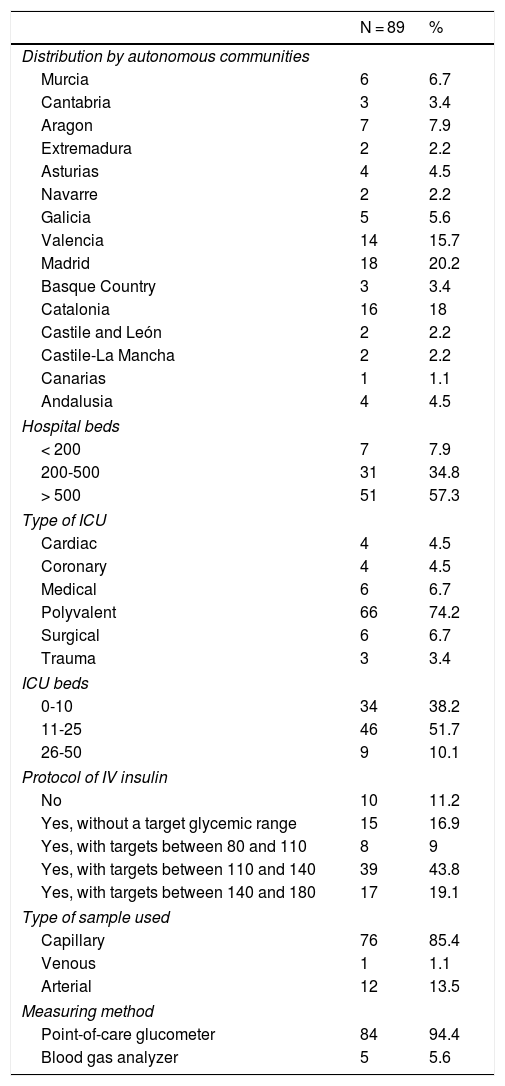According to the clinical practice guidelines on the management of sepsis,1 insulin should be administered after 2 consecutive glucose measurements > 180 mg/dL, and glucose levels should be kept between 110 mg/dL and 180 mg/dL. These guidelines recommend using arterial blood samples to control glycemia and studying them with blood gas analyzers. Point-of-care glucometers should only be used when the patient is a catheter-carrier subject, to draw venous or arterial blood samples, and the only alternative available is capillary puncture.2 State-of-the-art glucometers are very promising because of their reliability.3
Within the framework established by the national multicenter MOviPre study (Analysis of early mobilization in the intensive care setting in Spain) and, since hyperglycemia is a risk factor for muscle weakness, the collaborating investigators were asked whether their ICU had a protocol for glycemic control implemented and, when necessary, what the optimal glycemic range was, type of blood sample drawn, and type of analyzer used.
A total of 89 ICUs were surveyed, most of them polyvalent ICUs (74.2%) from public (97.8%), and teaching hospitals (87.6%) (Table 1).
Distribution by autonomous communities and characteristics of the ICUs surveyed.
| N = 89 | % | |
|---|---|---|
| Distribution by autonomous communities | ||
| Murcia | 6 | 6.7 |
| Cantabria | 3 | 3.4 |
| Aragon | 7 | 7.9 |
| Extremadura | 2 | 2.2 |
| Asturias | 4 | 4.5 |
| Navarre | 2 | 2.2 |
| Galicia | 5 | 5.6 |
| Valencia | 14 | 15.7 |
| Madrid | 18 | 20.2 |
| Basque Country | 3 | 3.4 |
| Catalonia | 16 | 18 |
| Castile and León | 2 | 2.2 |
| Castile-La Mancha | 2 | 2.2 |
| Canarias | 1 | 1.1 |
| Andalusia | 4 | 4.5 |
| Hospital beds | ||
| < 200 | 7 | 7.9 |
| 200-500 | 31 | 34.8 |
| > 500 | 51 | 57.3 |
| Type of ICU | ||
| Cardiac | 4 | 4.5 |
| Coronary | 4 | 4.5 |
| Medical | 6 | 6.7 |
| Polyvalent | 66 | 74.2 |
| Surgical | 6 | 6.7 |
| Trauma | 3 | 3.4 |
| ICU beds | ||
| 0-10 | 34 | 38.2 |
| 11-25 | 46 | 51.7 |
| 26-50 | 9 | 10.1 |
| Protocol of IV insulin | ||
| No | 10 | 11.2 |
| Yes, without a target glycemic range | 15 | 16.9 |
| Yes, with targets between 80 and 110 | 8 | 9 |
| Yes, with targets between 110 and 140 | 39 | 43.8 |
| Yes, with targets between 140 and 180 | 17 | 19.1 |
| Type of sample used | ||
| Capillary | 76 | 85.4 |
| Venous | 1 | 1.1 |
| Arterial | 12 | 13.5 |
| Measuring method | ||
| Point-of-care glucometer | 84 | 94.4 |
| Blood gas analyzer | 5 | 5.6 |
A total of 10% of the ICUs had not implemented any protocols for glycemic control as opposed to 15% that did have protocols implemented but without a proper definition of the optimal glycemic range was; 62.9% of all ICUs used ranges between 110 mg/dL and 180 mg/dL (Table 1).
A total of 85.4% of the ICUs used capillary puncture and 94.4% point-of-care glucometers for glycemic control. Only 36.2% of all glucometers used were the Accu-Check® model, a glucometer capable of reducing the bias generated by the hematocrit when measuring glycemia while only 1 ICU (1.2%) used the state-of-the-art Stata-Strip® glucometer.
The results confirm the findings of García del Moral-Martín et al.4 in Andalusia, Spain from a large and homogeneous national sample in terms of representativity by autonomous community. Indeed, although the evidence on how to monitor glycemia was first published over 5 years ago, it still has not made through the routine clinical practice. Although nurses rather draw samples from the arterial catheter, this is not a common practice to avoid the loss of blood associated with the volume of rejection, even though there are extraction methods with return systems to avoid the risk of anemia and any complications associated with cardiac catheterization (such as infection, catheter patency, thrombosis, and arterial ischemia).5 If a point-of-care glucometer should be used then it should be state-of-the-art device,3 that is practically unavailable in the ICUs studied.
The management of glycemia in the critically ill patient requires recommendations that should include the proper glycemic range, the minimum requirements that any insulin therapy protocol at the ICU setting should meet to reduce variability during glycemic control, and how to transition to intermittent subcutaneous insulin therapy.
Both scientific societies, the Spanish Society of Intensive and Coronary Unit Nursing (SEEIUC), and the Spanish Society of Intensive and Critical Care Medicine and Coronary Units (SEMICYUC) should back the recommendations made by experts and professionals from other specialties to facilitate the reading of glycemic levels, and implement the current evidence available on glycemic control and monitorization.
FundingThis project has been funded with a scholarship from the 2018 European Federation of Critical Care Nursing Associations (EfCCNa) Research Awards, and the III Health Research Award granted by Hospital Puerta de Hierro.
Conflict of interestsNone reported.
Please cite this article as: Raurell-Torredà M, Arias-Rivera S. Monitorización de la glucemia en cuidados intensivos. Estudio multicéntrico nacional. Med Intensiva. 2022;46:164–165.





